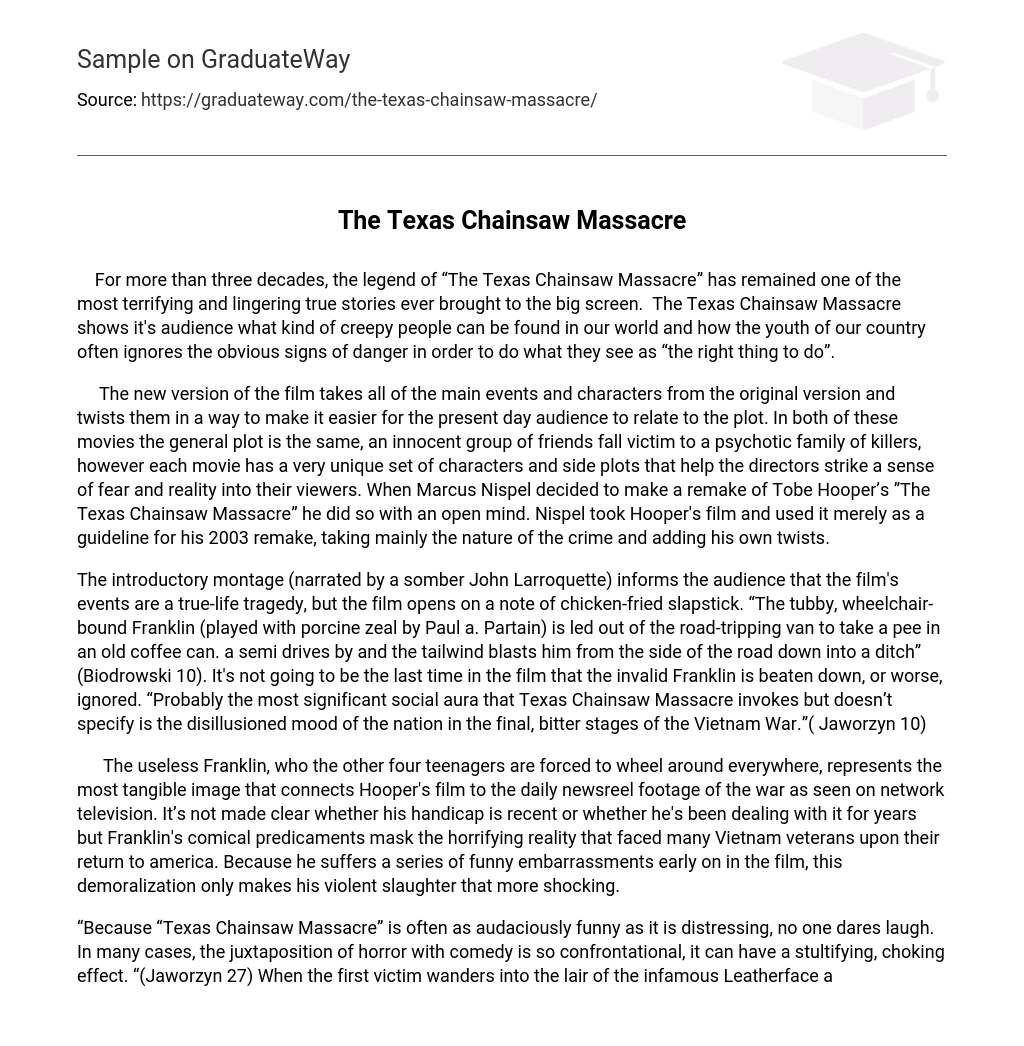For more than three decades, the legend of “The Texas Chainsaw Massacre” has remained one of the most terrifying and lingering true stories ever brought to the big screen. The Texas Chainsaw Massacre shows it’s audience what kind of creepy people can be found in our world and how the youth of our country often ignores the obvious signs of danger in order to do what they see as “the right thing to do”.
The new version of the film takes all of the main events and characters from the original version and twists them in a way to make it easier for the present day audience to relate to the plot. In both of these movies the general plot is the same, an innocent group of friends fall victim to a psychotic family of killers, however each movie has a very unique set of characters and side plots that help the directors strike a sense of fear and reality into their viewers. When Marcus Nispel decided to make a remake of Tobe Hooper’s ”The Texas Chainsaw Massacre” he did so with an open mind. Nispel took Hooper’s film and used it merely as a guideline for his 2003 remake, taking mainly the nature of the crime and adding his own twists.
The introductory montage (narrated by a somber John Larroquette) informs the audience that the film’s events are a true-life tragedy, but the film opens on a note of chicken-fried slapstick. “The tubby, wheelchair-bound Franklin (played with porcine zeal by Paul a. Partain) is led out of the road-tripping van to take a pee in an old coffee can. a semi drives by and the tailwind blasts him from the side of the road down into a ditch” (Biodrowski 10). It’s not going to be the last time in the film that the invalid Franklin is beaten down, or worse, ignored. “Probably the most significant social aura that Texas Chainsaw Massacre invokes but doesn’t specify is the disillusioned mood of the nation in the final, bitter stages of the Vietnam War.”( Jaworzyn 10)
The useless Franklin, who the other four teenagers are forced to wheel around everywhere, represents the most tangible image that connects Hooper’s film to the daily newsreel footage of the war as seen on network television. It’s not made clear whether his handicap is recent or whether he’s been dealing with it for years but Franklin’s comical predicaments mask the horrifying reality that faced many Vietnam veterans upon their return to america. Because he suffers a series of funny embarrassments early on in the film, this demoralization only makes his violent slaughter that more shocking.
“Because “Texas Chainsaw Massacre” is often as audaciously funny as it is distressing, no one dares laugh. In many cases, the juxtaposition of horror with comedy is so confrontational, it can have a stultifying, choking effect. “(Jaworzyn 27) When the first victim wanders into the lair of the infamous Leatherface and is beaten to death by a sledgehammer, Hooper mutes the man’s screams and substitutes them with a frightened hog’s squeals. That’s just one of many examples of Hooper using the friction of stylistic dichotomies to create an atmosphere of perversion and dread.
In the 1974 version of the film a group of teenagers are on their way to visit their grandfather’s grave, which takes them past a slaughterhouse and into the hands of the Hewitt family. Nispel takes these events and changes them in a way to better fit his audience, for example the general plot overview of the 2003 version is that a group of friends are passing through a small town in Texas on their way to a Lynard Skynard concert when they come across a troubled girl walking on the side of the road. The group of five stops to pick her up and to their surprise the troubled girl shoots herself in the head leaving them stuck in a town corrupted by the psychotic Hewitt family.
another significant difference between the two films is a noticeable change in characters. Between the two films there is really only one character that goes unchanged, Thom Hewitt, or otherwise known as “leather face”. one of what I found to be Nispel’s biggest mistakes was in changing the Hewitt family. In the 1974 version Hooper is able to create a dark sense of humor through the Hewitt family by giving them strange characteristics such as cannibalism. Hooper does a fantastic job of twisting their already disturbing habits to add a bit of humor to the film. “an example of this would be with grandpa Hewitt. Hooper take a crippled old man in a wheel chair who can barely lift his own head off of his shoulders and turns him into a ruthless x-murderer.”(Jaworzyn 42)
In one scene in the 1974 version the Hewitts even give their old, obviously dying grandpa a hammer to try his hand at killing one more time for old times sake, but because of the physical condition he is in he can not even hold the hammer long enough to hit the helpless girl. In my opinion this is one of the things Hooper did much better than Nispel.
although gruesome and ridiculous in nature this little bit of humor provides a perfect brake from the non-stop action, where in Nispel’s version the audience gets no break from the constant suspense of killing, which can make a movie tough to endure.
Bibliography
The Texas Chainsaw Massacre – Special Edition, 1974
“The Texas Chainsaw Massacre”. New Line Platinum Series, 2003
Jaworzyn, Stephen. The Texas Chain Saw Massacre Companion. Titan Books, 2003





